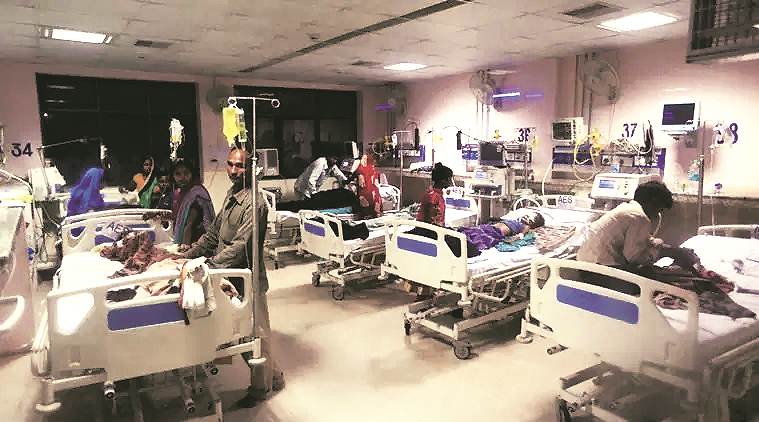- India
- International
Encephalitis cases fall but JE may be on rise in Gorakhpur
This year, according to records of the Baba Raghav Das (BRD) Medical College and Hospital, the main centre for treating the disease in the area, the overall encephalitis cases dropped but 22 of the 105 cases at the hospital were of JE at the beginning of the season.
 Most of the 1,300-plus children who died of encephalitis in Gorakhpur in 2017 were admitted to BRD Hospital. (Express File)
Most of the 1,300-plus children who died of encephalitis in Gorakhpur in 2017 were admitted to BRD Hospital. (Express File)
HAVING tapered post-2007, Japanese Encephalitis (JE) may have started resurfacing at Gorakhpur in Uttar Pradesh, with an expert in the field claiming that JE accounted for nearly 20 per cent of the encephalitis cases reported in the region this year.
Paediatrician Dr R N Singh, who has led the fight against the disease, warns that the success achieved via sanitation drives is in danger of being frittered away. This year, according to records of the Baba Raghav Das (BRD) Medical College and Hospital, the main centre for treating the disease in the area, the overall encephalitis cases dropped but 22 of the 105 cases at the hospital were of JE at the beginning of the season.
Most of the 1,300-plus children who died of encephalitis in Gorakhpur in 2017 were admitted to BRD Hospital.
Dr Mahima Mittal, who heads the paediatric department at BRD Hospital, says since then, encephalitis cases are on the decline in Gorakhpur, giving the example of the last two years, when numbers came down from 2,500 on an average to 1,047 in 2018. She attributes the decline largely to the state government’s sanitation drive.
However, Dr Singh says that even in the BRD figures of last year, 13 per cent were of JE, nearly double of 5-7 per cent in the last eight years.

Senior officials of the state, who spoke on the condition of anonymity, share Dr Singh’s concerns. Says an officer, “A door-to-door campaign to highlight the importance of hygiene, Dastak, was launched in January. We have intensified that campaign.”
Rajesh Mani, an activist who has petitioned the Allahabad High Court and the NHRC on the matter, contests the BRD Hospital figures. “Such a sharp drop in the disease is difficult to believe,” he says.
But, Dr Mittal says, the reason for this is a new pathogen in the encephalitis mix: scrub typhus. Unlike JE and enteroviruses (also known to cause encephalitis), scrub typhus is a bacteria but leads to symptoms similar to encephalitis. About 40 per cent of the encephalitis cases in Gorakhpur last year were scrub typhus cases, she argues, adding that it is much easier to treat and detect. “Scrub typhus can easily be identified with a scar near the elbow that seems like a burn mark left by a cigarette.”
A doctor at a primary health centre in Gorakhpur talks about how this “confusion” about the disease’s causative factors makes their job tougher.
Regretting that encephalitis was still not “demystified”, Dr Singh talks about the time he was a doctor at BRD Hospital in the 1970s, when the first JE cases were seen in the region. “We had very little means of diagnosing the disease, except analysing the spinal fluid.”
Between 1977 and 2004, JE claimed more than 500 children every year in Gorakhpur. By 2005, when a major outbreak killed more than 1,300 children, Dr Singh had left his post, seeking to “instrospect on where we were going wrong”.
In early 2006, he, along with families of JE victims, petitioned the government for a National Programme for Eradication of Encephalitis, and it agreed to a vaccination drive. By then, the National Institute of Virology (NIV) had also begun an extensive study on JE.
But while the effects of vaccination were visible after 2007, Dr Singh says, there was also “something perplexing”. “In spite of virology tests confirming the decline of JE, the deaths and rate of admission at BRD Hospital with the symptoms registered only a nominal decrease.”
It was in 2012 that the mystery was finally cracked, with scientists veering around to the NIV view that JE was just one part of the encephalitis mix in Gorakhpur. The NIV study found that it was not just mosquitoes spreading JE, but that around a hundred of the 1,000 samples tested showed the presence of another pathogen, enterovirus.
“These viruses spread through contaminated water and cause symptoms similar to JE,” the study said.
About why JE may be coming back, Dr Singh says there was one critical flaw in the vaccination programme.
The WHO norms prescribe a booster dose one to two years after the primary immunisation, which did not happen in Gorakhpur. Officials of the UP government admit to this flaw, promising correction.
Giving the example of polio, Dr Singh says, “It’s been more than seven years that polio was eradicated in India. Yet there is a vaccination drive against the disease. That’s necessary to build up herd immunity. Encephalitis doesn’t get similar attention of policymakers… For example, do we know why the disease is at its worst in Gorakhpur when it has receded in Bihar?”
Apr 25: Latest News
- 01
- 02
- 03
- 04
- 05







































